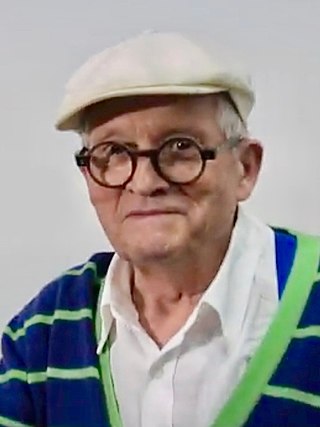Related Research Articles

Tate is an institution that houses, in a network of four art galleries, the United Kingdom's national collection of British art, and international modern and contemporary art. It is not a government institution, but its main sponsor is the UK Department for Culture, Media and Sport.

Vorticism was a London-based modernist art movement formed in 1914 by the writer and artist Wyndham Lewis. The movement was partially inspired by Cubism and was introduced to the public by means of the publication of the Vorticist manifesto in Blast magazine. Familiar forms of representational art were rejected in favour of a geometric style that tended towards a hard-edged abstraction. Lewis proved unable to harness the talents of his disparate group of avant-garde artists; however, for a brief period Vorticism proved to be an exciting intervention and an artistic riposte to Marinetti's Futurism and the Post-Impressionism of Roger Fry's Omega Workshops.

Bridget Louise Riley is an English painter known for her op art paintings. She lives and works in London, Cornwall and the Vaucluse in France.

Patrick Joseph Caulfield,, was an English painter and printmaker known for his bold canvases, which often incorporated elements of photorealism within a pared-down scene. Examples of his work are Pottery and Still Life Ingredients.

Laurence Stephen Lowry was an English artist. His drawings and paintings mainly depict Pendlebury, Greater Manchester as well as Salford and its vicinity.

David Hockney is an English painter, draughtsman, printmaker, stage designer, and photographer. As an important contributor to the pop art movement of the 1960s, he is considered one of the most influential British artists of the 20th and 21st centuries.

John Egerton Christmas Piper CH was an English painter, printmaker and designer of stained-glass windows and both opera and theatre sets. His work often focused on the British landscape, especially churches and monuments, and included tapestry designs, book jackets, screen prints, photography, fabrics and ceramics. He was educated at Epsom College and trained at the Richmond School of Art followed by the Royal College of Art in London. He turned from abstraction early in his career, concentrating on a more naturalistic but distinctive approach, but often worked in several different styles throughout his career.

Cecil Gordon Lawson was a British landscapist and illustrator.
Graham Vivian Sutherland was a prolific English artist. Notable for his paintings of abstract landscapes and for his portraits of public figures, Sutherland also worked in other media, including printmaking, tapestry and glass design.

The Whitworth is an art gallery in Manchester, England, containing over 60,000 items in its collection. The gallery is located in Whitworth Park and is part of the University of Manchester.

Sir William Rothenstein was an English painter, printmaker, draughtsman, lecturer, and writer on art. Though he covered many subjects – ranging from landscapes in France to representations of Jewish synagogues in London – he is perhaps best known for his work as a war artist in both world wars, his portraits, and his popular memoirs, written in the 1930s. More than two hundred of Rothenstein's portraits of famous people can be found in the National Portrait Gallery collection. The Tate Gallery also holds a large collection of his paintings, prints and drawings. Rothenstein served as Principal at the Royal College of Art from 1920 to 1935. He was knighted in 1931 for his services to art. In March 2015 'From Bradford to Benares: the Art of Sir William Rothenstein', the first major exhibition of Rothenstein's work for over forty years, opened at Bradford's Cartwright Hall Gallery, touring to the Ben Uri in London later that year.

Francis John Minton was an English painter, illustrator, stage designer and teacher. After studying in France, he became a teacher in London, and at the same time maintained a consistently large output of works. In addition to landscapes, portraits and other paintings, some of them on an unusually large scale, he built up a reputation as an illustrator of books.

John Leith Craxton RA, was an English painter. He was sometimes called a neo-Romantic artist but he preferred to be known as a "kind of Arcadian".
James Alan Davie was a Scottish painter and musician.
Kenneth Laurence Martin, was an English painter and sculptor who, with his wife Mary Martin and Victor Pasmore, was a leading figure in the revival of Constructionism.

Edward John Burra CBE was an English painter, draughtsman, and printmaker, best known for his depictions of the urban underworld, black culture and the Harlem scene of the 1930s.

John Trevor Hayes was a British art historian and museum director. He was an authority on the paintings of Thomas Gainsborough.

Sir Norman Robert Reid was an arts administrator and painter. He served as the Director of the Tate Gallery from 1964 to 1979.
Malcolm Hughes was a British constructive artist.

Charles Ernest Cundall,, , was an English painter of topographical subjects and townscapes, best known for his large panoramic canvases.
References
- ↑ "Kenneth Lawson: set designer". www.bafta.org. BAFTA. 11 May 2012. Retrieved 29 December 2021.
- 1 2 3 4 5 6 Ottewell, David (18 April 2010). "Obituary: Kenneth Lawson". Manchester Evening News. Retrieved 29 December 2021.
- 1 2 3 4 5 "Kenneth Lawson (1920-2008)". paintingsbykennethlawson.co.uk. Retrieved 29 December 2021.
- ↑ "Lawson, Kenneth, 1920–2008". artuk.org. Art UK. Retrieved 29 December 2021.
- ↑ "Kenneth Lawson: artist and set designer". The Times. 26 June 2008. Retrieved 29 December 2021.
- ↑ "'The Origins of the Land', Graham Sutherland OM, 1950–1". Tate. Retrieved 29 December 2021.
a memorandum of 4 April 1951 records the decision that a Mr Lawson should back-patch it and retouch the damage
- 1 2 Bailey, Fiona (24 September 2011). "Kenneth Lawson (1920 - 2008)". thewhitegallery. Retrieved 29 December 2021.